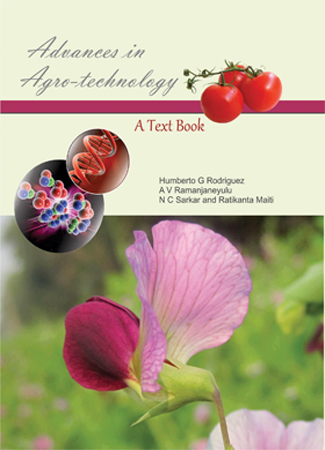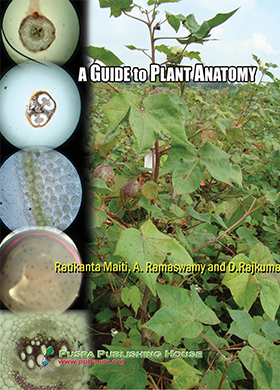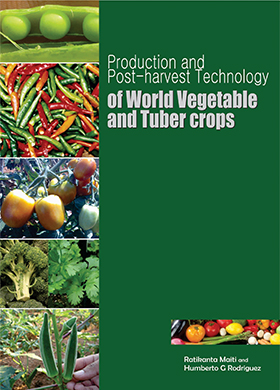Popular Article
Black Rice Cultivation in India – Prospects and Opportunities
Sanjoy Saha, S. Vijayakumar, Sanjana Saha, Ashirbachan Mahapatra, R. Mahender Kumar and R. M. Sundaram
- Page No: 044 - 048
- Published online: 27 May 2022
-
Abstract
ssahacrri@gmail.com
Black rice is known for its high nutritional value and is a source of iron, vitamin E, antioxidants, calcium, magnesium, zinc and contains more protein than brown rice. In India, it is grown in a large area in Manipur for a long time and is popularly known as Chak-hao, and desserts made from black rice are served as major feasts. As such, it offers several health benefits, including boosting eye and heart health, protection against certain forms of cancer, and aiding weight loss. Black rice is a healthier alternative to white rice that can be used in all of the same ways. There are great prospects to promote black rice cultivation in major rice-growing states of India and doing so will help our country to achieve nutritional security.
Keywords : Anthocyanin, Black rice, Forbidden rice, Nutritional value, Prospects
-
Introduction
Rice (Oryza sativa L.) is the second most important cereal in the world and it is the staple food for most Asians and over 90% of the world’s rice is produced and consumed in Asia. India is the second-largest rice-producing country in the world and the crop contributes over 42% to the annual food grain production of the country (Vijayakumar et al., 2021a). It is the staple food for more than 65% of the country’s population and also the most important source for meeting the calorie and dietary protein needs of the people. Mostly, white or brown rice is consumed in the world whereas black rice is consumed by a very small portion of people in Asia during the special occasions. It is a medium-grain, non-glutinous heirloom rice with a deep purple hue and a nutty, slightly sweet flavour. The dark colour of the grain is due to anthocyanin, a powerful antioxidant. Black rice has a deep black colour and usually turns deep purple when cooked. It is suitable for creating pooridge, dessert, cake, bread, kheer, noodles and many other dishes. The Japanese researchers analyzed the genome of 21 black rice varieties and found that the specific gene that triggers the plant to produce large amounts of anthocyanin (Oikawa et al., 2015).
In India, it has been playing a significant role in the socio-cultural practices of the indigenous Meitei community of Manipur for a long time (Asem, 2015). The Chak-hao Amubi is one type of sticky black rice that is indigenous to Manipur. ‘Chakho’ means delicious while ‘Ambui’ means black. In Manipur, it is generally served on special occasions and festive events. After cooking, the black hue turns purple and it has a slightly nutty flavour. Till now, Manipur is the highest producer of black rice in India.
Black rice also called forbidden rice because black rice was once reserved for the Chinese Emperor, for whom it was meant to ensure health and longevity. Historically, black rice was considered to be a royal delicacy and forbidden for common people in Asian countries such as China and Indonesia (Kushwaha, 2016). In China, during the imperial period, common people were not allowed to store/cultivate black rice without the approval from authorities hence it was called ‘forbidden rice’ or ‘imperial rice’ or emperor’s rice or purple rice or longevity rice.
-
Prospects of Black Rice in India
Growing black rice, which has its roots in north-east India, is becoming popular in other regions as well, among farmers. It’s extensively grown in Odisha, West Bengal, Tamil Nadu, Puducherry and Jharkhand and commonly consumed in Manipur. The demand for black rice has been increasing in today’s world because of its superior nutritional quality due to the presence of antioxidants and phenolic compounds. It is also rich in beneficial amino acids like lysine and tryptophan which possesses health benefits. Phenolic donate free radicle hydrogen act as singlet oxygen quenchers and protect the cell constituents against oxidative damage caused by free radical molecules. Black rice is generally consumed along with the bran due to the presence of anthocyanin and is sold as unmilled rice.
Black rice is found in larger supermarkets these days in the country at very high market price. Due to its high nutritional value and market price, there are great prospects to promote the cultivation of black rice in major rice-growing states in the country. Many State Agricultural Universities (SAUs) have started work to evaluate the performance of black rice varieties available in Manipur and other parts of north-eastern States with suitable production technologies. Initiatives should be taken to identify the potential areas of black rice cultivation and adequate awareness about its nutritional values and market price to the farmers of that particular region to promote black rice cultivation in the country.
-
Types of Black Rice
1. Black sticky rice: It has a sticky texture and the grain size is shorter. It is used to make sweet dishes in Asian countries. It is also known as Black glutinous rice.
2. Italian black rice: It has a rich aroma and the grains are long in size.
3. Black japonica rice: It has a mild sweet spiciness.
4. Thai black Jasmine rice: It is originated in Thailand and combines Jasmine rice with Chinese black rice. Floral Aroma is a characteristic of jasmine rice in Thailand and due to combination, it is also shown in Thai black Jasmine rice.
-
Major Health Benefits from Black Rice
The three major benefits of eating black rice are:
• It has great antioxidant properties
• Its anti-inflammatory actions
• Appetite, weight and fat-controlling properties
Other benefits
• Black rice is a good source of antioxidants that boosts immunity levels and helps the body stave off various ailments and infection
• It contains a large amount of anthocyanin, an ingredient that is capable of lowering the risk of a heart attack. It plays an important role in preventing plaque buildup in artery walls. Anthocyanin is more capable of controlling cholesterol levels than any other food supplement available today.
• It also prevents the onset of a series of illnesses like Alzheimer’s disease. Its consumption helps to prevent and cure certain types of cancer.
-
Nutritional Importance of Black Rice
Mostly, white or brown rice is consumed in the world but recently black rice has also gained importance because of its high nutritional value. Having black rice in your diet is the easiest way of protecting ourselves from diseases. Black rice contains a higher amount of nutrition that helps for better human growth. Modern nutritional science has shown that coloured rice is more nutritious than white rice, even after milling.
ü It has 9.1 grams of protein per 100 grams, while, white rice has 6.3 grams of protein per 100 grams
ü It contains 18 different amino acids, carotene and several other essential vitamins
ü Prevents Risk of Diabetes: It has a lower glycemic index, which is beneficial for diabetic patients and improves the production of adiponectin in the body which play a central role in the development of type 2 diabetes, obesity and cardiovascular disease in humans. To ward off the risk of diabetes and obesity, it is advised to consume whole grains instead of just refined carbohydrates.
ü Prevents Risk of Obesity: Black rice decrease levels of the hormone leptin, which is responsible for appetite-regulating.
ü In addition to beneficial pigments, they often contain higher amounts of minerals like iron and zinc and, sometimes, more protein, which improves the health of people.
5.1. Rich in Antioxidants
The outermost layer of the grain (pericarp), contains immense amounts of the antioxidant-anthocyanin even higher than any other grain, including brown rice, red rice, red quinoa, or other coloured whole grain varieties. The deep black or purple hue of the black rice is a marker of its high antioxidant properties. Anthocyanin provides several health benefits like anti-ageing, preventing cardiovascular disease, and restricting free radical movements which can cause a variety of diseases like diabetes and even cancer. It can also help improve brain function reduce inflammation and lower the risk of obesity (Sharma et al., 2018). Since black rice doesn’t undergo any refining or processing, it is able to retain its antioxidants, vitamins, minerals, and fiber. Black rice also contains another important antioxidant - Vitamin E, which is useful in maintaining eye, skin, and immune health.
5.2. Natural Detoxifier
The phytonutrients present in black rice help the body in cleaning disease-causing toxins (caused by free radicals). Black rice helps the liver (one of the most significant detoxifiers of the body) eliminate unwanted substances through its antioxidant activity.
5.3. Good Source of Fiber
The black rice has about 4.7 grams of fiber per 100 g. This rich fiber content helps in regulating bowel movements, and prevents constipation, diarrhoea and bloating. Fiber also binds with toxins and waste within the digestive tract and flush it all out of the system on completion of the cycle of digestion and gives the body a satiated feeling after consumption.
5.4. High Protein Content
The reason for nutritionist asking to cut down rice consumption is because of its high carbohydrate versus very less protein content. On contrary, black rice offers an increased amount of protein content over other common rice varieties. It contains 9.1 g of protein in a 100 g serving, while brown and red rice contains 8 g and 7 g of protein respectively for the same serving. On the other hand, polished white rice contains only 6.8 g of protein. Thus, eating protein rich black rice will alleviate protein malnutrition in Indian population (Vijayakumar et al., 2021b).
5.5. Better Heart Health
Eating black rice may have a positive impact on cholesterol levels too. The anthocyanin found in black rice reduces the Low-Density lipoprotein (LDL) cholesterol also known as the bad cholesterol, which is a common contributor to cardiovascular diseases. It also brings down the total cholesterol levels.
-
Economic importance of Black rice in India
6.1. North-East region
Black rice cultivation can generate great employment opportunities and farmers can earn higher profit from the sale of black rice due to its superior price. People living in Manipur in India’s Northeast have been growing Chak-Hao, the Indian variant of black rice and sold in the local markets at about Rs. 200 per kg or even more. The black glutinous aromatic rice of Manipur is in demand in the domestic market, as well as has possibilities for export. The black aromatic rice of Manipur is served in standard hotels as a top-rated variety. Rice flake prepared from black rice is becoming popular. Today, black rice is being cultivated in Assam and also in Uttarakhand, as its market grows along with the world’s appetite for antioxidant-rich, gluten-free staples. The recent successful venture of the Union Government at Amuguripara in Goalpara district in Assam, where a total of 12 tonnes of black rice was produced in 13.2 hectares, is an inspiring example. It shows by providing infrastructure, market support and financial incentives, black rice can, indeed, be good bet for Indian rice producers and consumers, domestic as well as foreign.
6.2. South India
In the Chettinad region of Tamil Nadu, people have been using their own black rice variety, Kavuni Arisi, which the old Chettiar traders had apparently brought with them from Burma. The cv. Kavuni Arisi is not a water guzzler like its hybrid cousins, thrives well in the arid districts of Tamil Nadu like Pudukottai and Karaikudi. And like Manipur’s Chak-Hao, it is used to make payasam, a traditional sweet from South India.
-
Production Technology of Black Rice
7.1. Climate preference for black rice
Black rice prefers a warm climate and long growing conditions of 3 to 6 months. It is generally sown in the month of June to July and harvested in January. For better germination, it requires a temperature of at least 21℃. Low temperature during maturity is highly necessary for higher yield and quality.
7.2. Cultivation of black rice
Healthy seeds should be used for seed purposes. 1% salt solution is used to remove inferior and chaffy seeds. Seed rate - 3 to 5 kg for one acre. Planting two seedlings per hill is normally recommended. Wider spacing facilitates strong plants and reduces lodging. Planting of two seedlings per hill normally followed. Seeds of black rice are soaked in water and after pre-germination, they are broadcasted in the puddled field. For good yield, it is also required to remove weeds as and when required. Fertilization is also practiced for increasing yields nowadays. Green manures like Sesbania spp. and plants like Azolla and Anabaena are mostly being used to meet the nutrient requirement of crops. Mostly black rice is produced through organic farming.
-
Future Research Need
No systematic work on the improvement of black glutinous aromatic rice has been taken up. However, germplasm collection, characterization and evaluation of these aromatic rice cultivars have been made in many research institutes. As the domestic demand for the black glutinous aromatic rice of Manipur increases, efforts are being made to develop high yield varieties without losing the grain’s quality, cooking quality and aroma. Black rice requires significantly less water and promoting its cultivation across the country will help in lifting farmer’s income and save irrigation water. There’s also an international market that is waiting to be penetrated. The idea of black rice cultivation, therefore, is catching on. The price of black rice is definitely more lucrative for farmers to make the switch. With marketers, organizations and e-commerce portals working overtime to reach out to an increasingly receptive market extending beyond India, the universe of takers for Chak-hao and other varieties of Indian black rice is only going to grow. Cultural beliefs and practices have a symbiotic relationship with the conservation of agro-diversity. Understanding such relationship is critical for in situ conservation of crop diversity in traditional agroecosystems for sustainable development of local communities. Black rice germplasms must be included in the All-India Rice Research Project based in Hyderabad, which will not only show its potential throughout India but also open the eyes of enterprising farmers.
-
Conclusion
Rice is the staple food crop in our country. Promoting black rice cultivation and its consumption will improve the nutritional status of poor farming communities. Research on black rice should be initiated in major institutions to improve its genetic potential. Also, the best package of production technology should be developed for each variety under different ecosystems. The state governments, where rice cultivation is a major enterprise, should take initiative to promote black rice cultivation. A niche market can be established primarily for export purposes.
Reference
-
Asem, I.D., Imotomba, R.K., Mazumder, P.B., Laishram, J.M., 2015. Anthocyanin content in the black scented rice (Chak-hao): its impact on human health and plant defense, Symbiosis 66(1), 47-54.
Kushwaha, U., 2016. Black Rice: Research, history and development, Springer, Switzerland.
Malia Frey, 2020. Black Rice Nutrition Facts and Health Benefits. Dec. 2. Available at https://www.verywellfit.com/black-rice-nutrition-facts-and-health-benefits-5083028. Accessed on 16-04-2022.
Oikawa, T., Maeda, M., Oguchi, T., Yamaguchi, T., Tanabe, N., Ebana, K., Yano, M., Ebitani, T., Izawaa, T., 2015. The Birth of a Black Rice Gene and Its Local Spread by Introgression. The Plant Cell 27, 2401–2414. DOI: https://doi.org/10.1105/tpc.15.00310
Sharma, S., Chunduri, V., Kumar, A., Kumar, R., Khare, P., Kondepudi, K.K., Bishnoi, M., Garg, M., 2018. Anthocyanin bio-fortified colored wheat: Nutritional and functional characterization. PLoS ONE 13(4), 1–16. https://doi.org/10.1371/journal.pone.0194367
Vijayakumar, S., Dinesh, Kumar., Dinesh, Jinger., Bhargavi, Bussa., Panda, B.B., 2021a. 4R nutrient stewardship based potassium fertilization for dry-direct seeded rice-wheat cropping system. Indian Farming 71(01), 22–25.
Vijayakumar, S., Sivashankari, M., Gobinath, R., Sanjoy, Saha., Prabhu, G., 2021b. Alleviating malnutrition through agronomic bio-fortification using value-added fertilizers. Indian Farming 71(01), 18–21.
Cite
Saha, S., Vijayakumar, S., Saha, S., Mahapatra, A., Kumar, R.M., Sundaram, R.M. 2022. Black Rice Cultivation in India – Prospects and Opportunities . Chronicle of Bioresource Management. 6,1(May. 2022), 044-048. DOI:.
Saha, S.; Vijayakumar, S.; Saha, S.; Mahapatra, A.; Kumar, R.M.; Sundaram, R.M. Black Rice Cultivation in India – Prospects and Opportunities . CBM 2022,6, 044-048.
S. Saha, S. Vijayakumar, S. Saha, A. Mahapatra, R. M. Kumar, and R. M. Sundaram, " Black Rice Cultivation in India – Prospects and Opportunities ", CBM, vol. 6, no. 1, pp. 044-048,May. 2022.
Saha S, Vijayakumar S, Saha S, Mahapatra A, Kumar RM, Sundaram RM. Black Rice Cultivation in India – Prospects and Opportunities CBM [Internet]. 27May.2022[cited 8Feb.2022];6(1):044-048. Available from: http://www.pphouse.org/cbm-article-details.php?cbm_article=65
doi = {},
url = {},
year = 2022,
month = {May},
publisher = {Puspa Publishing House},
volume = {6},
number = {1},
pages = {044--048},
author = { Sanjoy Saha, S Vijayakumar, Sanjana Saha, Ashirbachan Mahapatra, R Mahender Kumar , R M Sundaram and },
title = { Black Rice Cultivation in India – Prospects and Opportunities },
journal = {Chronicle of Bioresource Management}
}
DO -
UR -
TI - Black Rice Cultivation in India – Prospects and Opportunities
T2 - Chronicle of Bioresource Management
AU - Saha, Sanjoy
AU - Vijayakumar, S
AU - Saha, Sanjana
AU - Mahapatra, Ashirbachan
AU - Kumar, R Mahender
AU - Sundaram, R M
AU -
PY - 2022
DA - 2022/May/Fri
PB - Puspa Publishing House
SP - 044-048
IS - 1
VL - 6
People also read
Popular Article
Liquid Nano-Urea: An Emerging Nano Fertilizer Substitute for Conventional Urea
K. Lakshman, M. Chandrakala, P. N. Siva Prasad, G. Prasad Babu, T. Srinivas, N. Ramesh Naik and Arjun KorahLiquid Nano Urea, Nano technology, Nutrient use efficiency
Published online: 28 Jun 2022
Popular Article
Broomrape (Orobanche sp.) Management in Indian Mustard
Tanmay Das, Teekam Singh and Prakash SonnadBroomrape, mustard, parasitic weeds
Published online: 28 Mar 2023
Popular Article
Black Rice Cultivation in India – Prospects and Opportunities
Sanjoy Saha, S. Vijayakumar, Sanjana Saha, Ashirbachan Mahapatra, R. Mahender Kumar and R. M. SundaramAnthocyanin, Black rice, Forbidden rice, Nutritional value, Prospects
Published online: 27 May 2022
Popular Article
Precision Nitrogen Management Using Leaf Colour Chart
M. Ramesh Naik and S. HemalathaCereals, decision support system, leaf colour chart, nitrogen
Published online: 30 Jun 2021
Demography and Dynamics of Commonly Harvested Woody Species in A Protected Forest Reserve-Western Zimbabwe
J. MudekweDemography, species, population, conservation, expanding, declining
Published online: 07 Jun 2017



.jpg)
.jpg)






